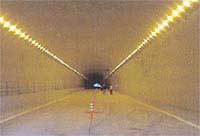For the first time, Vietnam has successfully designed, supervised, and directed the construction of a complex technical project without the assistance of any foreign experts. This achievement is represented by the Ngang Pass road tunnel, which utilizes new technology developed by a team from the Transport Design Consulting Corporation.
 |
View of the Ngang Pass road tunnel. (TEDI) |
The innovative technological solution led by engineer Ngo Xuan Thinh won second place at the Vietnam Scientific Creativity Competition 2005 (VIFOTEC). This success resulted from a technology transfer program during the construction of the Hai Van road tunnel, where Vietnam partnered with Nippon Koei from Japan and Louis Berger International from the United States.
The road segment through Ngang Pass is approximately 7 km long, located on National Road 1A, which runs through the two provinces of Ha Tinh and Quang Binh. The total length of the new route is 2.8 km, including a 495 m long road tunnel. The tunnel section specifically utilized a design and construction method based on new Austrian technology, abbreviated as NATM.
Mr. Ngo Xuan Thinh, the project leader, stated that Vietnam is the first country among developing nations to boldly implement NATM tunneling technology in constructing traffic tunnels. Domestic engineers and road workers designed, supervised, and directed the construction of a project using complex new technology without any expert assistance. The total funds saved by not hiring experts amounted to approximately 21 billion VND.
Throughout the design and construction supervision process, the engineers successfully resolved the economic and technical challenges of the project, utilizing many local materials and fabricating equipment such as deformation measuring mirrors, support frame systems, and anchoring systems, thereby replacing imported materials while ensuring equivalent quality.
 |
Ngang Pass road tunnel. (TEDI) |
The construction process lasted 16 months and was completed in August 2004. After more than a year of operation, the traffic volume through the tunnel exceeded projections. The project has alleviated traffic difficulties along the North-South route, shortening the distance by 4.5 km, reducing operating costs, and minimizing traffic accidents on the pass road. Moving forward, the research team plans to apply this new technology to construct road tunnels in Thanh Hoa and railway tunnels in Thai Nguyen.
Mr. Thinh believes that the completion of the Ngang Pass road tunnel project opens up prospects for Vietnam to independently design and construct many more road tunnels, railway tunnels, and highways with high geometric standards in the coming years. This also marks a milestone demonstrating that Vietnam has reached a regional level in the field of bridge and road construction.



















































